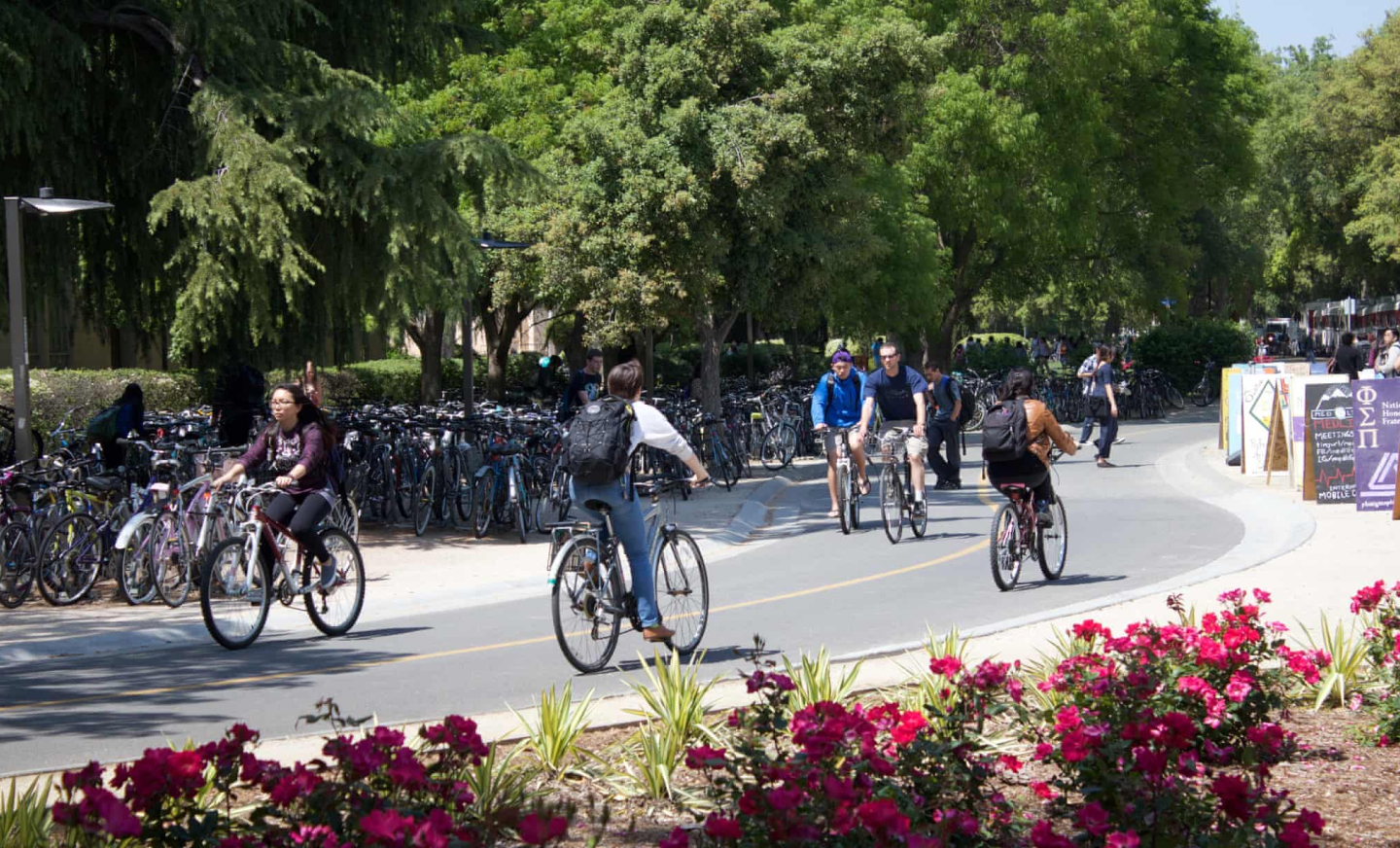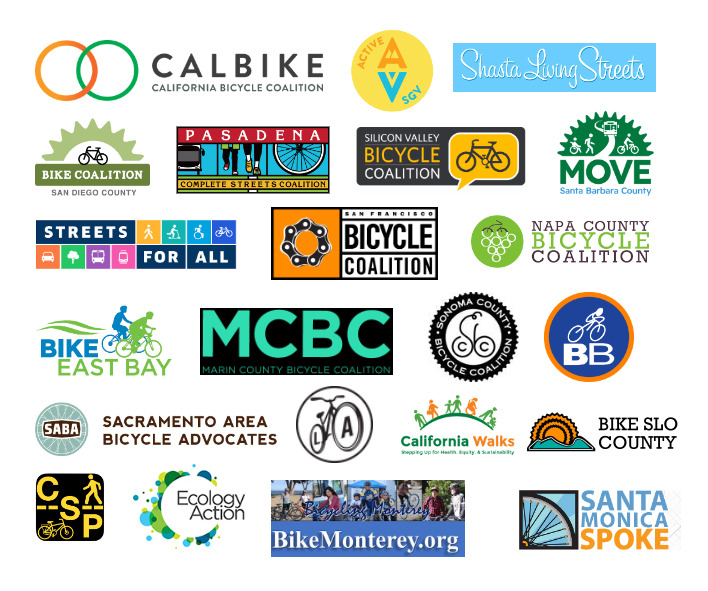For Immediate Release: August 10, 2023
Contact: Kevin Claxton, Interim Executive Director, (909) 274-0137, kevin@calbike.org
California Bicycle Advocates Call on Elected Leaders to Address Real Causes of Deadly Collisions: Road Design
In July of 2023, a person driving a van hit a 15-year-old bike rider in Encinitas who later died of his injuries. Witnesses reported that the teenager “did everything right,” following the rules of the road, which his father publicly stated that he “loved teaching him.” In response, the Encinitas City Council declared an “e-bike emergency.” A front-page New York Times article used this tragic death to advance the theory that teenagers riding e-bikes are behind a rise in collisions. The author singles out teens as the most dangerous riders but lumps all e-bikes into the same category and fails to mention the role of unsafe infrastructure in this and other crashes involving e-bike riders.
There is no doubt an emergency on our streets: Vehicular-caused fatalities set a record in California in 2021, with 4,285 lives lost to traffic violence. The number declined slightly in 2022 to 4,099, but it’s higher than any of the last 40 years of NHTSA data.
In 2021, 124 people riding bikes and 1,108 people walking were killed by motor vehicle drivers on California roads. People on foot accounted for a quarter of all vehicular driver-caused deaths; people biking and walking are killed by traffic violence at disproportionate rates compared to their mode share. And these figures represent only fatalities; they don’t reflect the thousands of lives forever altered by traffic-related injuries, or the grieving families, friends, and communities of those who were tragically and unnecessarily killed.
So, yes, we do have a crisis. And yes, it is an emergency. Traffic violence is accelerating, with vulnerable road users most at risk.
However, this is not an “e-bike emergency” that can be solved by limiting or over-regulating people who use e-bikes. An elite bike racer was killed in San Francisco earlier this year, and an experienced teenage cyclist — a Junior Men’s National Champion— was killed by a driver in Colorado just this week while riding a regular bike; no amount of skill or education can save a person on a bike from a careless driver or our outdated and unsafe infrastructure.
Pinning the blame on e-bikes obscures the real problem. For example, 2022 was Oakland’s worst year for road fatalities in over 10 years, with 35 deaths. That included 15 people killed while walking and at least three people killed while riding bikes. None of the people riding bikes was on an e-bike, yet Oakland, like most California communities, is suffering from a surge in traffic violence.
Facts about e-bikes and street safety:
- NHTSA data show California highway fatalities trending upward since 2010, long before e-bikes became popular.
- Deaths of people riding bikes declined 8% between 2020 and 2021, as the number of people riding e-bikes increased, according to the Office of Traffic Safety. During that same period, OTS reports pedestrian deaths increased by 9.4%.
- Many more pedestrians die in traffic collisions than bike riders (1,108 vs. 125 in 2021, according to OTS). Safety for vulnerable road users is an emergency that won’t be solved by regulating e-bikes.
- IIHS data show a 55% increase in people on bikes dying in traffic collisions from 2010 to 2021. Despite recent hysteria about teens on e-bikes, most of those who died (90%) were aged 20 or older. During this period, deaths of bike riders under 20 decreased by 90%, while fatalities among those over 20 increased by 400%.
E-bikes make bicycling accessible to a broader range of people, including seniors and people with disabilities. The rapid adoption of e-bikes has led to more bikes on California roads and, while studies have shown that there’s safety in numbers for people riding bikes, nothing can replace well-designed, safe infrastructure such as protected bike lanes, bike boxes, and protected intersections.
In fact, in more than one of the fatalities that have led to emergency declarations in Southern California cities, infrastructure gaps are the root cause. A recent study by the Federal Highway Administration found that upgrading a traditional bike lane to a separated bike lane with simple flexible delineator posts cuts a bicyclist’s crash risk in half, and crash risk is further reduced with more substantial separation. So we know what infrastructure solutions reduce conflicts between people on bikes and people in cars, but they aren’t being implemented.
The current crisis is caused by our inability to build a safe transportation network, which is needed even more urgently now to meet the explosive demand for low-cost, green transportation for all people, not just those in cars.
Emergency declarations that focus on e-bike restrictions and education without addressing a Safe Streets for All approach and creating safe biking infrastructure are bound to fail. In May of 2022, Carlsbad imposed restrictions on bike use, including both e-bikes and regular bicycles, but that didn’t keep two people on bikes from being killed in a single week in August of 2022.
Focusing on e-bikes when people are dying because they’re forced to share unsafe roadways with speeding cars and trucks is ineffective.
We call on California’s decision-makers to:
- Increase the budget of the Active Transportation Program (ATP), which funds safe biking and walking infrastructure. Communities want to build better roads, but that takes money, and the ATP consistently lacks funding to greenlight many of the worthwhile projects that apply.
- Either as part of the ATP or separate from it, support cities with funding and technical assistance to implement networks of quick-build bicycle and pedestrian infrastructure. This will prevent deaths and help California reach its climate goals.
- Because the infrastructure we need is not just specific to biking and walking, create new statewide funding programs for the implementation of traffic-calming infrastructure.
Jared Sanchez, Policy Director
California Bicycle Coalition
Kevin Shin, Deputy Director
California Walks
Eris Weaver, Executive Director
Sonoma County Bicycle Coalition
Sharlene Liu, Lead
Bike Sunnyvale
Chloé Lauer, Executive Director
San Diego County Bicycle Coalition
Heather Deutsch, Executive Director
MOVE Santa Barbara County
Kara Vernor, Executive Director
Napa County Bicycle Coalition
Anne Thomas, Executive Director
Shasta Living Streets
Justin Hu-Nguyen, Co-Executive Director of Mobility Justice
Bike East Bay
Glenn Hammett, President
Bike Bakersfield
Rick Ellison, Executive Director
Bike SLO County
Deb Banks, Executive Director
Sacramento Area Bicycle Advocates
Sandhya Laddha, Policy Director
Silicon Valley Bicycle Coalition
Eli Akira Kaufman, Executive Director
Bike LA
Janelle Wong, Executive Director
San Francisco Bicycle Coalition
Ross Pringle
Claremont Streets For People
David Diaz, Executive Director
Active San Gabriel Valley
Tarrell Kullaway, Executive Director
Marin County Bicycle Coalition
Mark Vukcevic, Director of State Policy
Streets For All
Colin Bogart, Steering Committee
Pasadena Complete Streets Coalition
Piet Canin, Strategic Development Director
Ecology Action
Mari Lynch, Founder
Bicycling Monterey
Cynthia Rose,
Executive Director





